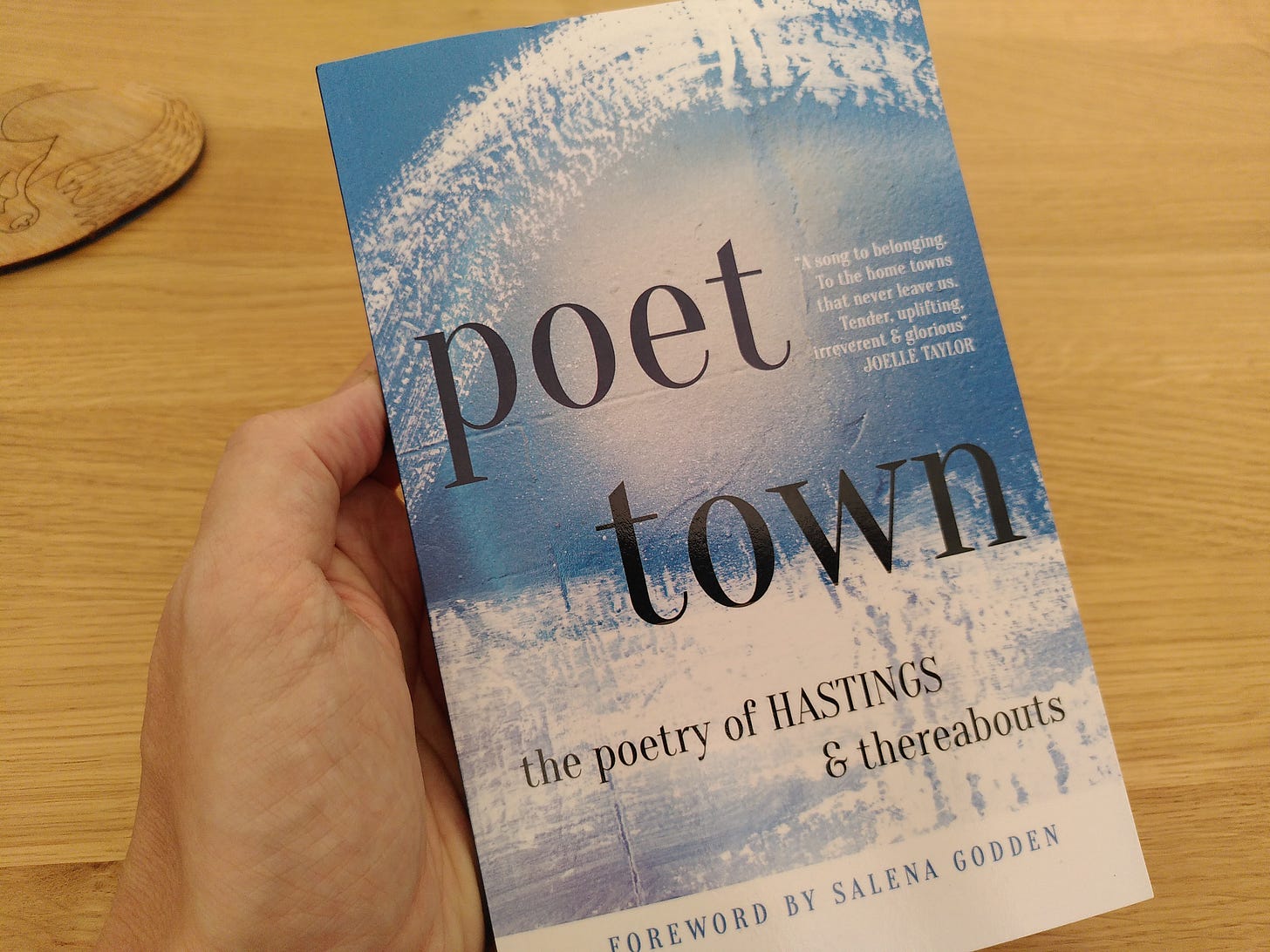NB. This piece is duplicated from my Substack, Stray Bulletin, and was originally published on October 17th.
With the new university semester and two new Sidekick Books titles imminent now well-and-truly arrived, it’s time for a significant update to Stray Bulletin, recounting key happenings from the year so far. This is the last of three parts, released substantially later than the first two!
Part 1: Events! | Part 2: Reviews & Critical Writing! | Part 3: New Work!
I write a lot. I just don’t publish a lot — of my own work, that is. Partly because much of it takes a long, long time to fully crystallise — I’m still regularly pulling up and rethinking poems that were first drafted well over a decade ago. But also, I find I drift further and further from the general trend. Easy, I know, to fixate on what doesn’t suit you and disparagingly label it ‘the general trend’, but I think it’s not unkind or too reductive to say that the majority of poetry sought and published by English-language editors today constitutes first-hand accounts of relatable experiences taking place in something like the real contemporary world, in which the poet — or someone you can well believe is the poet — is reassuringly present.
You don’t have to look far, of course, to find complaints about UK poetry being dominated by identity politics. But if we only slightly expand that category to include any poem which revolves around, or circles back to, a persona of the poet conveying something of their values, then I suspect most complainants are caught in their own net.
Work of a different kind is permitted, even celebrated, but less readily, I sense, when the editor or critic does not know the poet from Adam. On the performance circuit, you do find more in the way of fantastical conceits — these, however, are mostly either comically ludicrous or intended as satire. The ‘general trend’, as far as there is one, is surely to look on poetry as, primarily, a performance of the self.
Tiny Assassins
So what do I think I’m doing that’s so damned different?
Well, one thing I’ve done this summer is make four more A8 microbooks to sell blind-bagged for £2 at book fairs. Each one is made of a single piece of A4 paper, folded and cut into a booklet, held together with a cover jacket folded from an A6 sheet. They’re tiny examples of ‘amalgamatic writing’, in that the contents are a mixture of quotes from various media, very short scholarly extracts, lists and poetry.
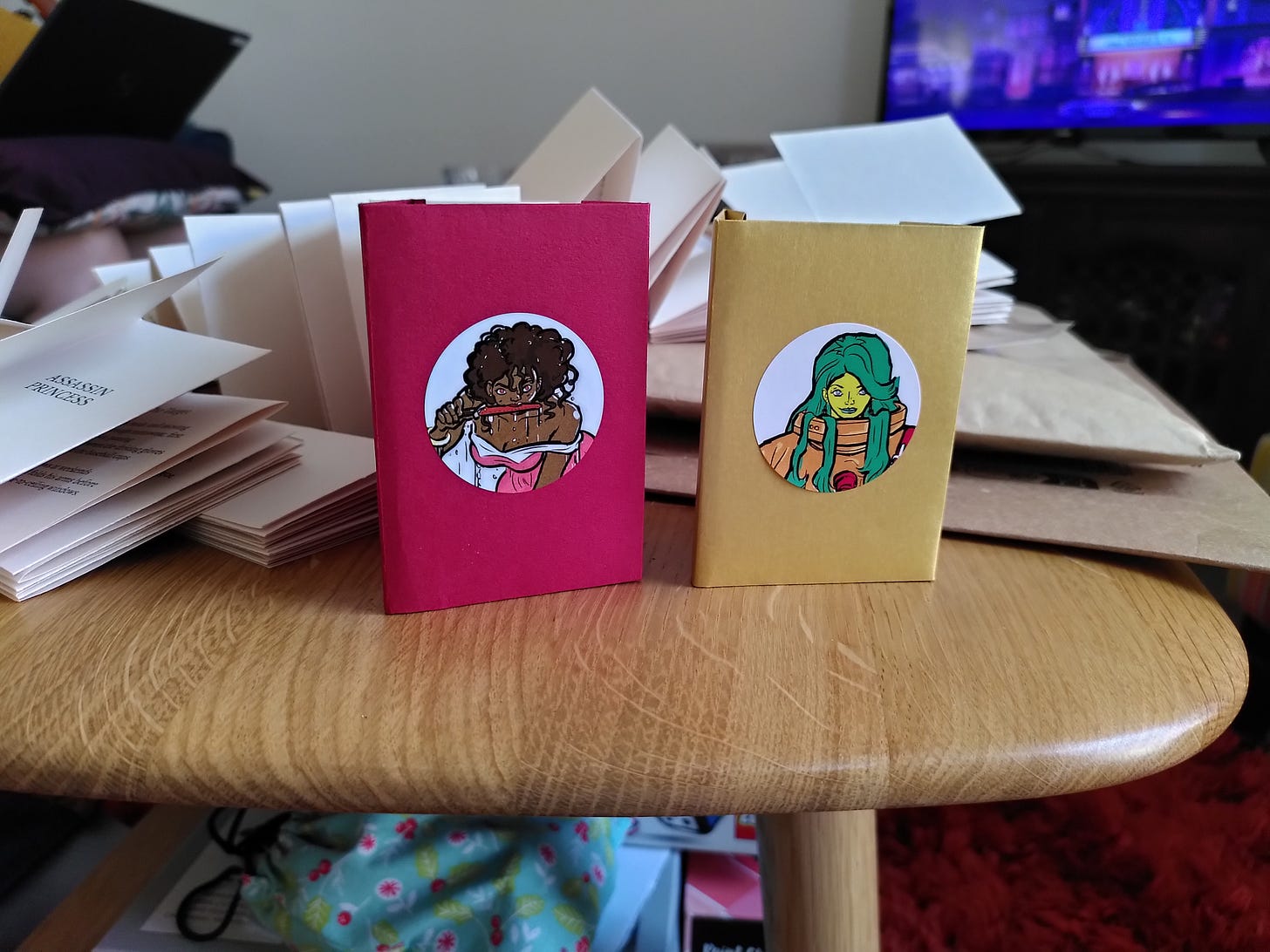
The theme for this latest set is ‘Action Princesses’ — a short explanation on the inner back page reads “exploring cult evocations of feminine power and sexuality”. I wrote one new piece for each book, and all of them are the kind of poems I would estimate as having a close-to-zero chance of being considered by editors of most journals. They’re mostly in third-person, and where there’s a speaker, it’s definitely not me. They also belong utterly to the cult genres their protagonists inhabit, even as they (mildly) spoof them. There’s no zoom-out to Cambridge, UK, 2025. This is from ‘Space Princesses’:
One is pinned by her skirt to a cosmic dartboard.
One is lashed by her heart to a handsome meathead.
One is trapped in a shrinking skintight spacesuit.
One is frogged, one spatchcocked, sputnikked, splayed out.
Not for long, though – nothing can hold them forever.
No beam, no jaw, no kiss rolled over and over.
See what I mean? The 21st century’s rejection of b-movie mash-up is Caliban’s fury at not seeing his face reflected in the mirror.

Booze Boutique
I have managed to find the odd piece a home. One appears in a wonderful little journal of “computational poetry and literary art” called Taper. Their restrictions on submissions are extreme: “All code (in the form of ES6, CSS, and HTML) must be placed between the template’s closing header tag (</header>) and the closing body tag (</body>), must be valid HTML5, and must fit within 2KB (2048 bytes).”
One byte is one character, so that’s 2,048 characters (spaces included) for both the code and every iteration of the poem itself.
I read these and other guidelines carefully, and figured ‘The Whisky Shop’ would have a much better shot here than anywhere else — not just because of the interactive element, but because it’s in second-person:
You, lolling like a gloomy embryo.
The cellar like an exhibition hall.
Ingots, many buried long ago –
a library of sacred texts to trawl.
You see, I’m not recalling the whisky shop. You are. And while the second-person ‘you’ can easily be another kind of persona, in this case I think it’s clear that it isn’t just a way of writing about myself. I have, in fact, been to a whisky shop (that’s where I got the idea for the poem) but in an entirely different mood to that which pervades throughout this piece. There is no specific experience of my own (other than seeing the contents of a whisky shop) that I’m out to convey.
Do read/play the other pieces in this issue, by the way, if you enjoyed those game poems I mentioned in my last Stray Bulletin entry.
Flood Warning
I’ve previously had three of a set of five labyrinth poems published in various (well, two) poetry journals: Long Poem Magazine and the sadly discontinued Raceme. I’ve sent a fourth one out to a couple of places, but without high hopes — not only is it, again, in second-person, again drawing on old monster movie tropes, but it’s also impossible to read a stanza at a time. You have to read across the stanzas, following a trail back and forth. And you have to do this twice, once for each of the two parts of the poem.
Luckily, the perfect occasion came up to do something with it. Angus Allman, compere of CB1 Poetry and director of the upcoming Cambridge Poetry Festival revival, arranged for a collaborative event with ARU’s MA Illustration and Design courses. As part of this, two students took my labyrinth poem and created a set of artworks based on it.
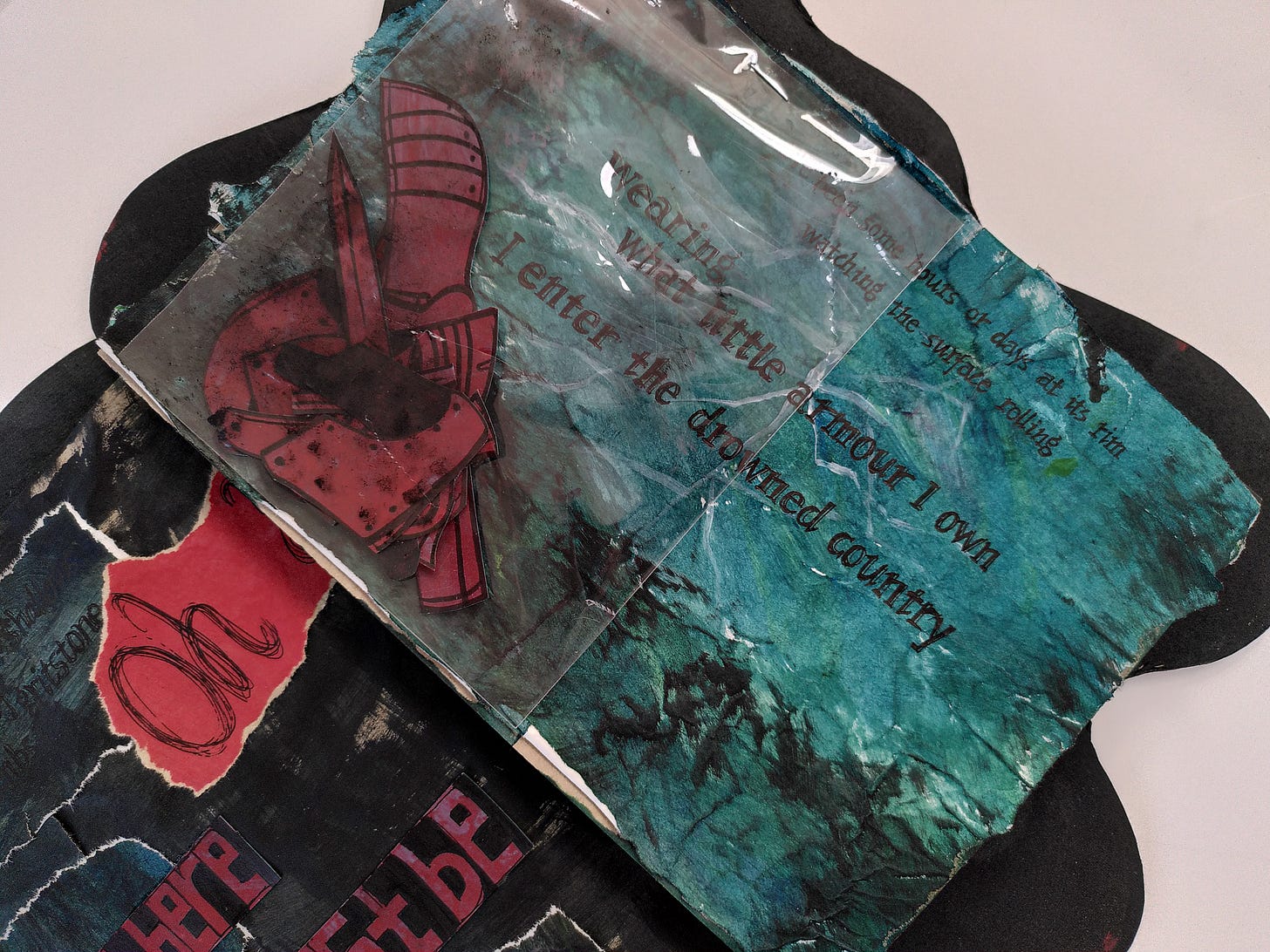
This was exciting enough in itself (I love what they did and now have two of the pieces hanging in my house). But then there was an entire exhibition of these and other artworks, with the poems displayed alongside them, and a closing night where we performed these to a gathered crowd.
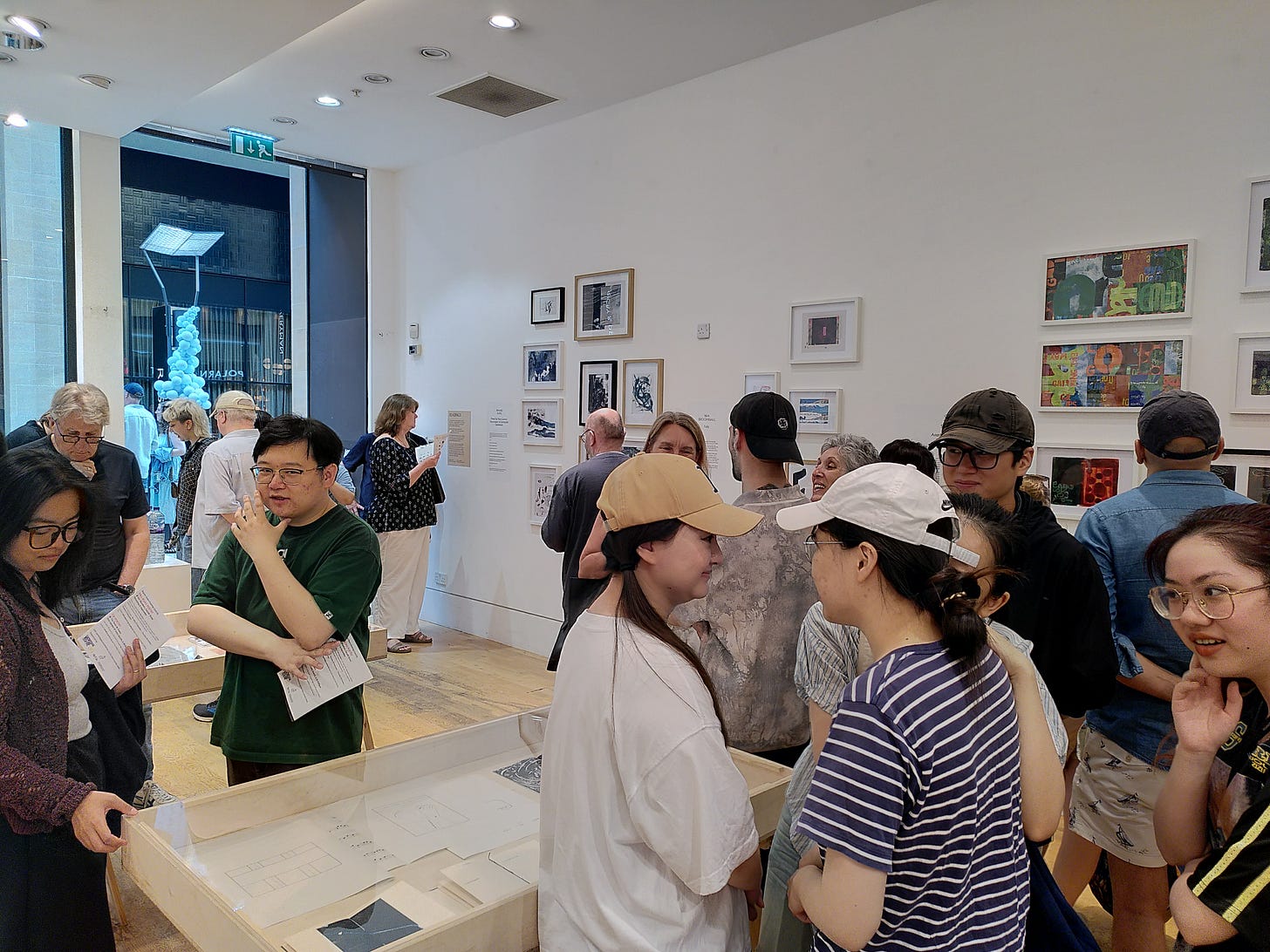
And and and … a souvenir booklet!:
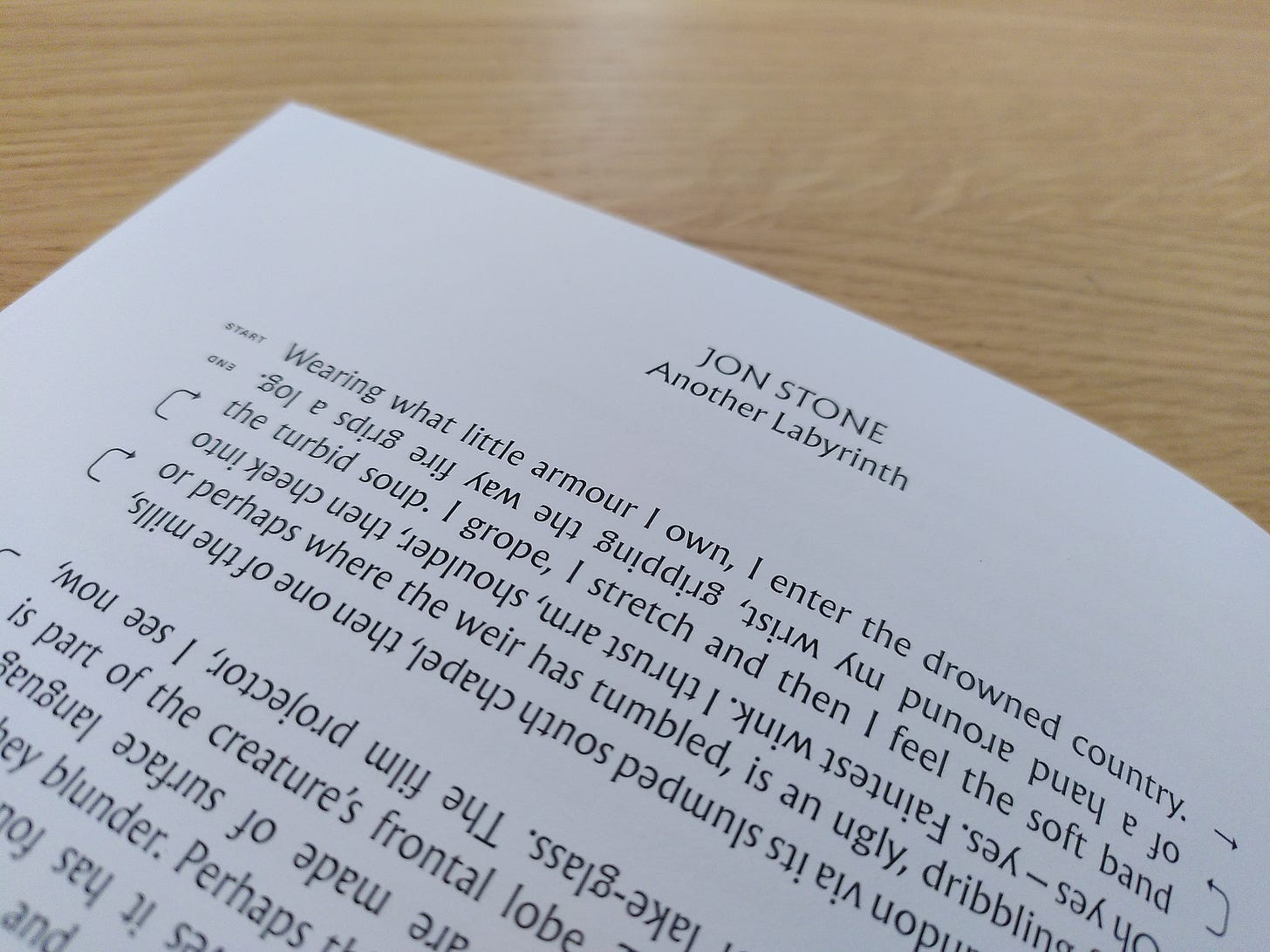
To close us out
That about brings us up to speed with recent publications, except to say that I’ve taken the three micro-RPG poems that I originally made for a miniscule batch of summer pamphlets, converted them to digital-interactive form and put them out in itch.io. Each one is based on a different game I played in 2022. One has been rewritten quite extensively, so it works better in this form.
I’ve also performed a major clear-out, reducing the mass of papers, print-outs, photos, correspondence, essays (and so on) that I have accumulated throughout my life to the contents of a single cupboard. As part of this process, I uncovered enough old stories to think it worth starting to document them. You can find a post about the earliest of those stories here.
And finally — finally, finally, in this massive three-part catch-up entry — one of the tasks that occupied me during the summer was typesetting a project spearheaded by my old friend, Richard Newham-Sullivan. Poet Town: The Poetry of Hastings & Thereabouts is by far the biggest book I’ve ever typeset, easily topping Lives Beyond Us: Poems and Essays on the Film Reality of Animals. There are four editions, two with colour photos! And there are dozens of poets in there — about as varied a bunch as you’re likely to encounter anywhere. Who knew Hastings was such a cultural powerhouse?
